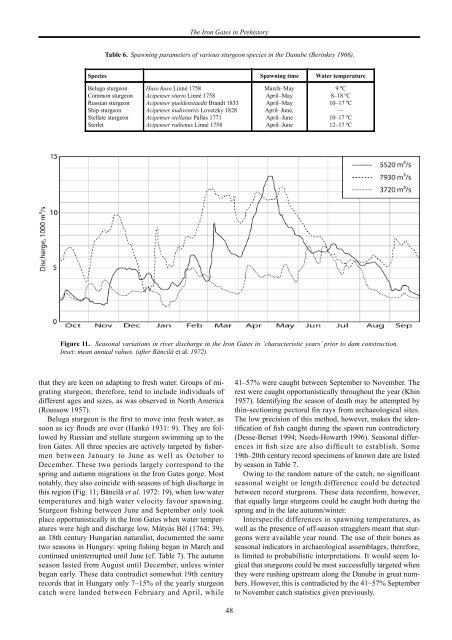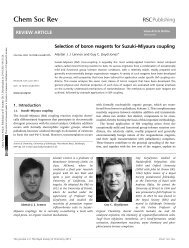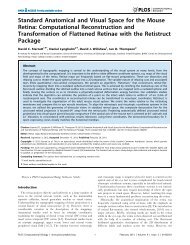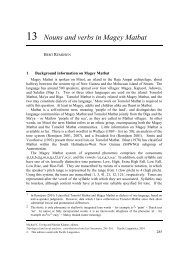Sturgeon fishing in the middle and lower Danube region László ...
Sturgeon fishing in the middle and lower Danube region László ...
Sturgeon fishing in the middle and lower Danube region László ...
Create successful ePaper yourself
Turn your PDF publications into a flip-book with our unique Google optimized e-Paper software.
that <strong>the</strong>y are keen on adapt<strong>in</strong>g to fresh water. Groups of migrat<strong>in</strong>g<br />
sturgeon, <strong>the</strong>refore, tend to <strong>in</strong>clude <strong>in</strong>dividuals of<br />
different ages <strong>and</strong> sizes, as was observed <strong>in</strong> North America<br />
(Roussow 1957).<br />
Beluga sturgeon is <strong>the</strong> first to move <strong>in</strong>to fresh water, as<br />
soon as icy floods are over (Hankó 1931: 9). They are followed<br />
by Russian <strong>and</strong> stellate sturgeon swimm<strong>in</strong>g up to <strong>the</strong><br />
Iron Gates. All three species are actively targeted by fishermen<br />
between January to June as well as October to<br />
December. These two periods largely correspond to <strong>the</strong><br />
spr<strong>in</strong>g <strong>and</strong> autumn migrations <strong>in</strong> <strong>the</strong> Iron Gates gorge. Most<br />
notably, <strong>the</strong>y also co<strong>in</strong>cide with seasons of high discharge <strong>in</strong><br />
this <strong>region</strong> (Fig. 11; Bǎncilǎ et al. 1972: 19), when low water<br />
temperatures <strong>and</strong> high water velocity favour spawn<strong>in</strong>g.<br />
<strong>Sturgeon</strong> <strong>fish<strong>in</strong>g</strong> between June <strong>and</strong> September only took<br />
place opportunistically <strong>in</strong> <strong>the</strong> Iron Gates when water temperatures<br />
were high <strong>and</strong> discharge low. Mátyás Bél (1764: 39),<br />
an 18th century Hungarian naturalist, documented <strong>the</strong> same<br />
two seasons <strong>in</strong> Hungary: spr<strong>in</strong>g <strong>fish<strong>in</strong>g</strong> began <strong>in</strong> March <strong>and</strong><br />
cont<strong>in</strong>ued un<strong>in</strong>terrupted until June (cf. Table 7). The autumn<br />
season lasted from August until December, unless w<strong>in</strong>ter<br />
began early. These data contradict somewhat 19th century<br />
records that <strong>in</strong> Hungary only 7–15% of <strong>the</strong> yearly sturgeon<br />
catch were l<strong>and</strong>ed between February <strong>and</strong> April, while<br />
The Iron Gates <strong>in</strong> Prehistory<br />
Table 6. Spawn<strong>in</strong>g parameters of various sturgeon species <strong>in</strong> <strong>the</strong> <strong>Danube</strong> (Ber<strong>in</strong>key 1966).<br />
Species Spawn<strong>in</strong>g time<br />
Beluga sturgeon<br />
Common sturgeon<br />
Russian sturgeon<br />
Ship sturgeon<br />
Stellate sturgeon<br />
Sterlet<br />
Huso huso L<strong>in</strong>né 1758<br />
Acipenser sturio L<strong>in</strong>né 1758<br />
Acipenser gueldenstaedti Br<strong>and</strong>t 1833<br />
Acipenser nudiventris Lovetzky 1828<br />
Acipenser stellatus Pallas 1771<br />
Acipenser ru<strong>the</strong>nus L<strong>in</strong>né 1758<br />
48<br />
March–May<br />
April–May<br />
April–May<br />
April–June,<br />
April–June<br />
April–June<br />
Water temperature<br />
9 ºC<br />
8–18 ºC<br />
10–17 ºC<br />
—<br />
10–17 ºC<br />
12–17 ºC<br />
Figure 11. Seasonal variations <strong>in</strong> river discharge <strong>in</strong> <strong>the</strong> Iron Gates <strong>in</strong> ‘characteristic years’ prior to dam construction.<br />
Inset: mean annual values. (after Bǎncilǎ et al. 1972).<br />
41–57% were caught between September to November. The<br />
rest were caught opportunistically throughout <strong>the</strong> year (Kh<strong>in</strong><br />
1957). Identify<strong>in</strong>g <strong>the</strong> season of death may be attempted by<br />
th<strong>in</strong>-section<strong>in</strong>g pectoral f<strong>in</strong> rays from archaeological sites.<br />
The low precision of this method, however, makes <strong>the</strong> identification<br />
of fish caught dur<strong>in</strong>g <strong>the</strong> spawn run contradictory<br />
(Desse-Berset 1994; Needs-Howarth 1996). Seasonal differences<br />
<strong>in</strong> fish size are also difficult to establish. Some<br />
19th–20th century record specimens of known date are listed<br />
by season <strong>in</strong> Table 7.<br />
Ow<strong>in</strong>g to <strong>the</strong> r<strong>and</strong>om nature of <strong>the</strong> catch, no significant<br />
seasonal weight or length difference could be detected<br />
between record sturgeons. These data reconfirm, however,<br />
that equally large sturgeons could be caught both dur<strong>in</strong>g <strong>the</strong><br />
spr<strong>in</strong>g <strong>and</strong> <strong>in</strong> <strong>the</strong> late autumn/w<strong>in</strong>ter.<br />
Interspecific differences <strong>in</strong> spawn<strong>in</strong>g temperatures, as<br />
well as <strong>the</strong> presence of off-season stragglers meant that sturgeons<br />
were available year round. The use of <strong>the</strong>ir bones as<br />
seasonal <strong>in</strong>dicators <strong>in</strong> archaeological assemblages, <strong>the</strong>refore,<br />
is limited to probabilistic <strong>in</strong>terpretations. It would seem logical<br />
that sturgeons could be most successfully targeted when<br />
<strong>the</strong>y were rush<strong>in</strong>g upstream along <strong>the</strong> <strong>Danube</strong> <strong>in</strong> great numbers.<br />
However, this is contradicted by <strong>the</strong> 41–57% September<br />
to November catch statistics given previously.









